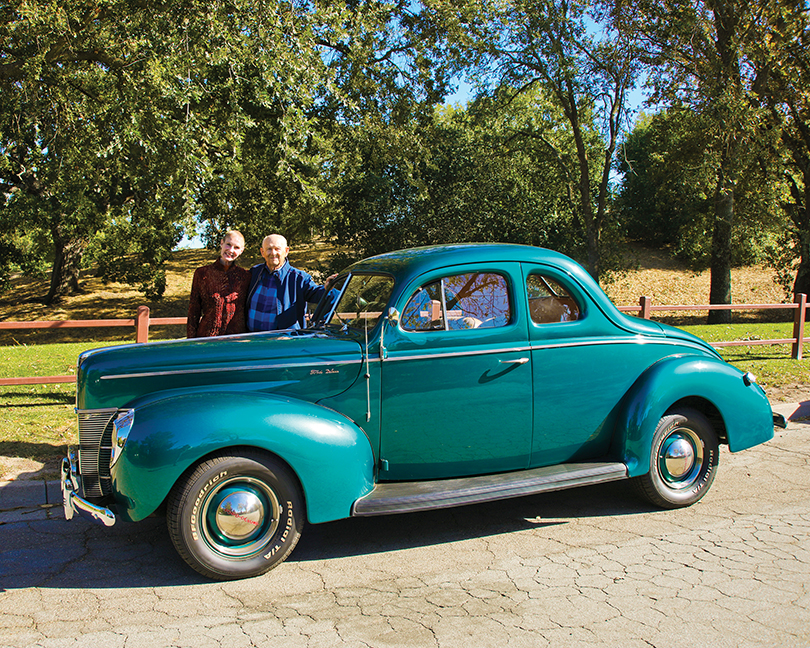Norman Prickett’s interest in automobiles began as a child, while working in his father’s automotive garage in Piedmont, California. At first, he just cleaned tools, but by the time he reached age twelve, he started working on and overhauling cars. The repair shop remained at that location for about six years, until his dad became frustrated with politics in the big city. Then, his father, who had grown up on a Nebraska farm, decided to move the family back to the small community of Hamilton City, between Orland and Chico, near the Sacramento River. There, his father leased a huge World War II Quonset hut, to be used as a two-story repair shop. He named it “Pappy’s Auto Repair,” Pappy being his father’s nickname.
The family lived on the hut’s upper floor, with the repair shop below. The building had extensions on both sides. One side contained a machine shop and the other side was rented to a tenant who sold arc welders. The building was wide enough that the central work area could contain about 16 cars at one time. Norman lived there until he graduated from high school; a high school with a senior graduating class of only 32 students.

Norman didn’t see much future in Chico or the surrounding area. When he returned to the Bay Area after graduation, he found a job as an apprentice on construction crews. When he was 19 he got his journeyman’s card and soon ran work crews until age 21. He then joined the Army. After his Army service, he came back to the Bay Area and again ran a construction crew for a while, then obtained a part-time real estate sales license while still working in construction. Eventually, realizing how much money he could make in the real estate business, he became a full-time realtor. Following another inspirational and motivational moment in his life, he started buying old houses and fixing them up. Before long, he began building spec homes, apartments and condos, which led him into his lifetime work in managing, building, and selling real estate.
Norman doesn’t consider himself a collector of cars, but purchasing good cars became his passion—cars that he could drive to and from work and enjoy on a daily basis. When he finished his military service in 1965, he bought a green 1965 Pontiac GTO convertible with a black top, which he loved. However, one day while driving a couple around in that car, the wife got out of the car and told her husband that she never wanted to ride in that vehicle again. It became obvious that the back seat of the car was not the most comfortable for taking customers out to see properties. Wisely, Norman sold his GTO and purchased a larger vehicle—a new station wagon that could accommodate more people comfortably.
In 1989, while on a drive in Sacramento, his wife, Sherry, pointed out a Red 1965 GTO convertible and asked Norman if this wasn’t the same type of car that he had owned previously and spoke fondly of many times. She suggested that he take a look at it, which he did. He then bought it and brought it home. It had the wrong engine and a few other things wrong with it, but he soon found the correct engine and installed it. Originally, it was a tri-power, four-speed transmission car with factory air, which was unusual for a convertible. Consequently, it was quite a rare vehicle. He later modified it further with a four-barrel carburetor, replaced the four-speed transmission with an overdrive automatic transmission, and upgraded the old air-conditioning unit with a more modern one. After making the changes, that GTO is what he now considers his primary highway car. In fact, it has taken them to Canada, Texas, Yellowstone, and Las Vegas, and is now a vehicle that his wife, Sherry, also enjoys driving.
At one time he owned as many as five vehicles. One of his favorite cars was a 1950 Ford coupe that he purchased 50 years ago, in 1970. A friend of his called him one day and told him that he had found a 1940 Ford sitting underneath a tree in a backyard in Castro Valley. It had a near perfect body for restoration, but no motor or transmission. Norman purchased it and towed it home. He installed a small block Chevy engine in it and drove it with a stock transmission and rear end for 30 years. He then added a brand-new engine, a new rear end, air conditioning, and completely rewired the car. Today, this 1940 Ford even has power steering, power brakes disc brakes on the front, and is almost a brand-new car. He also owned a Ford Ranchero for 15 years, which he sold last year. Prior to that, he had a 230 SL Mercedes that he drove for 18 years.
Norman reminded me that he did the mechanical work on these cars himself, and “remember,” he said, “I’m not a car collector. I simply like to buy and maintain great cars and keep them in great condition for the pure enjoyment of driving them.”
And for the right price, he may eventually sell his exquisite 1940 Ford coupe and seek another adventure!
Leave a Reply